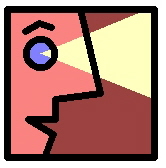 I know what you’re thinking: My child can see perfectly. I can skip this blog. But there’s more to vision than just seeing. Children with sensory integration dysfunction often have problems processing visual information, even though they can “see.” (If you have concerns about your child’s basic ability to see properly, click here.)
I know what you’re thinking: My child can see perfectly. I can skip this blog. But there’s more to vision than just seeing. Children with sensory integration dysfunction often have problems processing visual information, even though they can “see.” (If you have concerns about your child’s basic ability to see properly, click here.)
I often notice that my son Kyle will put objects close to his eyes when he’s playing or thinking. Kyle has normal vision but I believe he is under-sensitive to visual stimuli. That means he craves visual input, and so he watches video clips repeatedly, creates movement and shadow in his line of sight, and examines objects up close. He likes to twiddle his fingers in front of his eyes, or put papers so close that they brush against his eyelashes.
 The ability to see things, like a letter on a chart, is only one aspect of vision. For example, your child might have difficulty playing catch because she is unable to visually judge distances as the ball moves toward her. Or he might have a hard time tracking an airplane as it flies through the sky, because his oculomotor skills—the ability to make his eyes move together efficiently—are lacking. Sometimes these difficulties are subtle and hard to detect. Yet if the problems remain undiagnosed, your son or daughter could develop learning disabilities, or have social and emotional troubles.
The ability to see things, like a letter on a chart, is only one aspect of vision. For example, your child might have difficulty playing catch because she is unable to visually judge distances as the ball moves toward her. Or he might have a hard time tracking an airplane as it flies through the sky, because his oculomotor skills—the ability to make his eyes move together efficiently—are lacking. Sometimes these difficulties are subtle and hard to detect. Yet if the problems remain undiagnosed, your son or daughter could develop learning disabilities, or have social and emotional troubles.
 The good news is that vision therapy is available for these kids. It is obtained either through occupational therapy or sensory integration therapy. Vision therapy (or vision training) can help the child to better process visual information through assisted practice. It’s a good idea to get this kind of therapy started as soon as possible once a problem is recognized. This can prevent more serious learning disabilities from appearing later on.
The good news is that vision therapy is available for these kids. It is obtained either through occupational therapy or sensory integration therapy. Vision therapy (or vision training) can help the child to better process visual information through assisted practice. It’s a good idea to get this kind of therapy started as soon as possible once a problem is recognized. This can prevent more serious learning disabilities from appearing later on.
Here are twelve symptoms of visual dysfunction to “watch” for in your child:
- She may tilt her head as she’s counting, reading, or watching a video.
- He may squint his eyes or put his hands to his eyes frequently.
- When she writes, she may markedly slant her lines up or down across the paper. Her spacing between letters and words may be irregular.
- He may have a hard time finding subtle differences between two symbols or images, and doing things like puzzles or word searches may be very frustrating.
- Sports may be difficult because she cannot seem to “keep her eye on the ball” and can’t time her swing or kick efficiently.
- He may seem klutzy, and frequently misjudges distances between steps, or the space between objects. Therefore he trips or bumps into objects frequently.
- She might confuse her right from her left and get lost or disoriented at times.
- It might be hard for him to change his focus from far away to near. Taking notes while a teacher speaks at the front of the classroom could prove difficult, because he has to switch his eye gaze back and forth.
- She may dislike reading and can’t concentrate. She may have a hard time picturing what she’s reading in her mind. It’s hard for her to relate to characters or find meaning in written text.
- He may have headaches or complain of seeing double.
- Social situations where there is a lot of activity and movement may overwhelm her.
- Terms like first and second, big and bigger, higher and lower, etc., may cause him frequent confusion.
In your child’s next IEP meeting, or if he already has occupational therapy, ask about a vision assessment and vision training. You may see a number of his difficulties improve through this specialized therapy.

